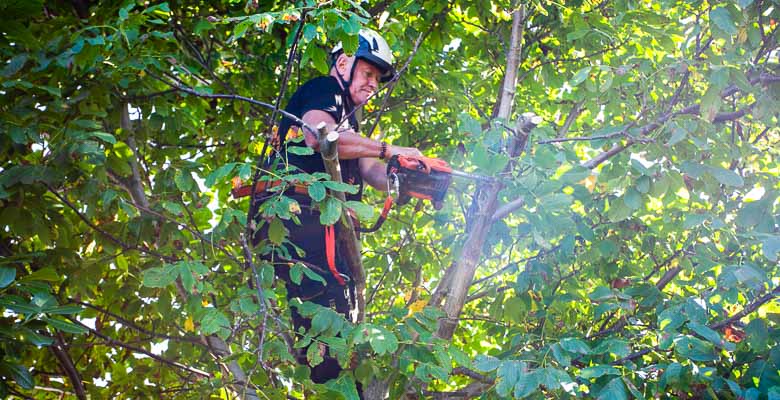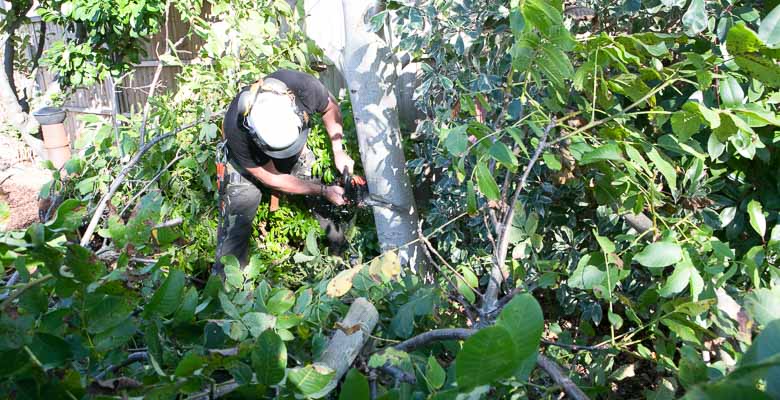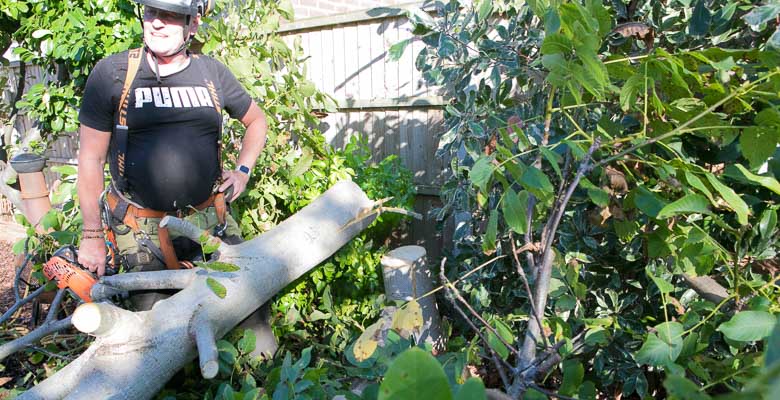The cost to remove a tree can vary quite drastically depending on the scale of the job.
Felling a small to medium-sized standard tree with easy access will cost around £400 – 700 and take between half a day and a day to complete based on two labourers.
For a large tree with restricted access or bad health, the cost runs into several thousand pounds and a timeline of two to three days based on a bigger team of people.
The jump in price reflects the scale of the work. A large tree requires more planning, equipment and manpower and is also more difficult to remove.
Want accurate quotes for your project?
Post a job and tree surgeons near you will get in touch to provide a quote. It’s free, fast and no obligation.
Average cost to cut down a tree
Below are some rough tree removal costs based on size. Always make sure to check what a quote includes (in particular whether it includes the cost to remove the stump as well).
| Size | Cost |
| Small | £150 – 500 |
| Medium | £500 – 1,500 |
| Large | £1,500 – 2,500 |
| Extra large | £2,500+ |
| Get quotes | |
The cost to remove a tree depends on the following factors:
Tree size
The larger a tree is, the more expensive it will be to cut down. Felling a large tree usually requires a tree surgeon to climb the tree. This involves more equipment, more time and a bigger team of labourers to assist the process of felling the tree, removing it and ensuring safety protocols are followed.

The species and number of trees
Tree removal is generally priced at an hourly or daily rate. The more trees to be removed, or the more difficult the species is to work with, the longer the job will take.
Accessibility
If a tree is near a building, a powerline or is otherwise difficult to access in some way, it will need more effort and time to remove. This is because the tree surgeon can’t simply cut the tree down. Greater care will have to be taken to organise the felling zone to ensure no one is harmed.
What’s more, the tree surgeon will have to cut the tree into smaller pieces to be roped down (where a rope is tied around the branch and lowered to the ground rather than tossed down as is standard). This will take more labour and time, resulting in a higher price.
Location
Labour costs vary across the country, with London and the south-east costing more than the north.
Company
A large tree surgery firm with an established reputation may charge more than a small company. For example, the average cost for a two to three-person team is £400 per day. However, it is not uncommon for bigger companies to charge a daily rate of over £700.
Smaller companies are often under the VAT threshold, meaning they don’t add 20% to the cost.
Tree health
Diseased or otherwise unhealthy trees are particularly dangerous to work on because they become brittle and therefore more difficult to control. Greater care has to be taken to remove them which means longer on the job.
Waste removal
Make sure to ask if the removal of waste is included in a quote. While most do, others charge it as a fee on top of the job. The cost to remove waste begins at around £100.
Stump removal
Tree stumps can be removed at any time, but organising stump removal alongside tree removal is the most convenient option and will generally cost upwards of £100 depending on the diameter of the stump.
Read our tree stump removal cost guide for more information.
Root removal
Trees with a large root system require a lot more work to remove. Cherry trees, for example, are known for having problematic roots that can take longer to remove than other species.
Free Service
How can I tell if a tree needs to be removed?
The best way to find out if a tree is diseased and needs to be removed is to organise a survey by a tree surgeon.
There are signs which signal that your tree is suffering from poor health. If you notice any of these, consider contacting a specialist.
- Fungi (such as mushrooms) growing at the base of the trunk
- Chipped or peeling bark and cracks in the trunk
- Long, overhanging branches
- Detached roots
- Cavities or decay in the trunk
- A lack of leaves or leaves that are unseasonably brown
General tree care and upkeep are often a condition of home insurance. It is therefore important that trees are inspected occasionally and any necessary work carried out to make sure they remain safe and healthy.
Do I need permission to cut down a tree in my garden?
Whether or not you can cut down a tree in your garden depends on two things:
- If you own your home: Tenants will need to get their landlord’s sign-off before they can remove a tree, while homeowners do not need permission to fell a tree that’s solely within their garden unless it is protected.
- If the tree is protected: Neither a homeowner nor a tenant can cut down a tree that is subject to a Tree Preservation Order (TPO) or falls in a Conservation Area.
If you’re in doubt about the legalities of removing a tree, you can always seek advice from your local council or relevant government department.
- Forestry Commission (England)
- Scottish Forestry
- Natural Resources Wales
- Northern Ireland Forest Service
Alternatively, you can organise a survey by an arborist who will be able to advise you on your responsibilities and options.
For more information on TPOs, the rules on Conservation Areas and tree surveys, read our tree removal guide where we cover everything in more detail.
Felling a tree is an expensive job; you’re not alone if you’ve found yourself caught off guard by the price of a quote. But the cost to remove a tree is a direct reflection of the demands of the job.
If you’re in any doubt, make sure to ask your tree surgeon for a breakdown of the quote, as well as for feedback from their previous clients. As a rule of thumb, go for a person you feel comfortable with over a low price.
What does removing a tree involve?
There are two methods of removing a tree; sectional tree felling and straight tree felling. Which technique a tree surgeon uses is determined by the size of the tree and its accessibility.
Straight tree felling
Straight tree felling is where the tree is cut at the base and falls in a controlled manner. Arborists use this method for small or medium sized trees or if there is enough space around the tree to establish a safe falling zone. It involves cutting a notch in one side of the tree before making the felling cut on the other.
Sectional tree felling
Sectional tree felling, on the other hand, involves sectioning and dismantling the tree in parts. This technique is used for large to extra large trees (which require aerial operation) or when the site offers limited space. It involves cutting branches and limbs one at a time and guiding them to the ground with lowering ropes to ensure they land in a safe zone.

Free Service
Frequently asked questions
Below we cover some of the frequently asked questions about removing a tree.
Why is tree removal so expensive?
Tree surgery is a highly skilled and dangerous job. The cost reflects the inherent risks involved in the work, as well as the expensive equipment and insurance required to do it properly and safely.
Does insurance cover tree removal?
Most insurers cover falling trees as standard, so you’re likely to be covered for any resulting damage.
That said, if there is any damage to your property or possessions caused by lopping, topping or felling of trees on your property as a result of a tree surgeon carrying out work – you should be covered by their insurance which is why it is important you check they have it.
Subsidence (when the tree roots absorb water from the soil causing it to contract and affect the foundations of the house) is also typically covered in a housing insurance policy, but it is worth double-checking.
Heave, when the water balance in the soil has become reliant on the moisture being removed by the tree’s roots and the removal of the tree floods the earth around the house, is also covered by most home insurance policies.
However, when it comes to heave or subsidence, the excess is usually much higher than ordinary claims as the remedial work is typically very costly.
When should a tree be cut down?
As a general rule, the best time to cut down a tree is during the dormant season, between winter and early spring. Dormant trees are leafless and lighter, so it’s easier for a tree surgeon to handle and cut the branches.
However, just as different types of trees require different types of care, several factors may go into deciding when it is time to remove a specific tree. So the best thing to do is organise a survey by a tree surgeon.
Can I cut down a tree myself?
It depends on the tree. If the tree is small enough that you don’t need to climb it or require a ladder, then it may be possible for you to safely remove it yourself. However, there is also a question of the tree’s health and location.
Diseased trees are fragile and prone to unexpectedly breaking, while a tree that is located near a building or powerline, for example, will need special care to make sure no damage occurs when it falls.

All in all, tree surgery is best left to a professional who is trained to handle the risks associated with felling a tree.
How much does it cost to cut down a conifer?
Like any species of tree, the cost to remove a conifer comes down to the job itself. In other words;
- The number of conifers to be removed
- The size of the conifers
- Accessibility and location of the trees
- Your location
- Waste, stump and root removal
The standard rate for a day’s work, based on two to three tree surgeons, is £400 – 500 (this will be higher in London and the south-east). For more labour and intensive work (one to three days), the cost will be upwards of £1,000.
So if you’re ready to get started, post a job to get quotes from tree surgeons near you.
Free Service
About our data
We survey home owners about the tree removal quotes they receive, and tree surgeons about how much they charge. We use this data to help create our tree removal cost guide.
Author
Written by, Adam Clark, trade specialist at My Local Toolbox.